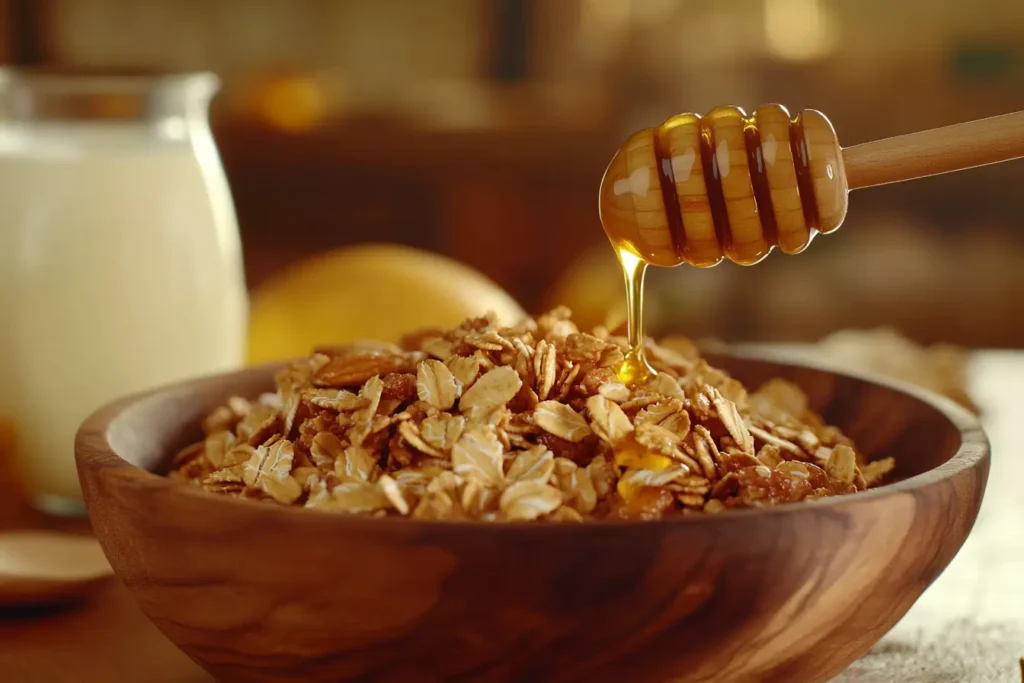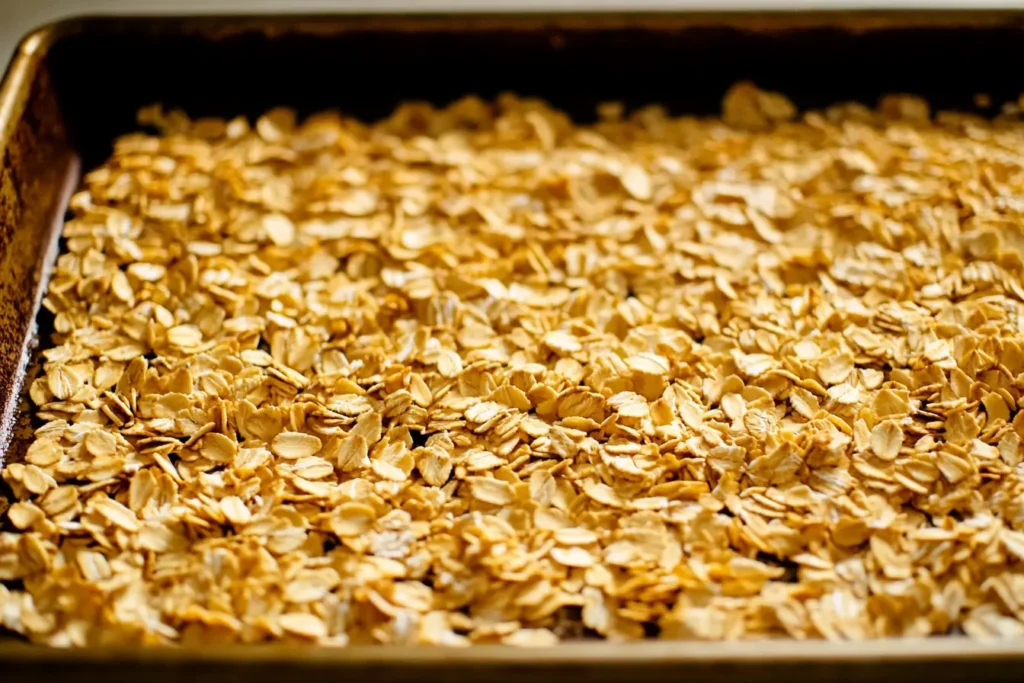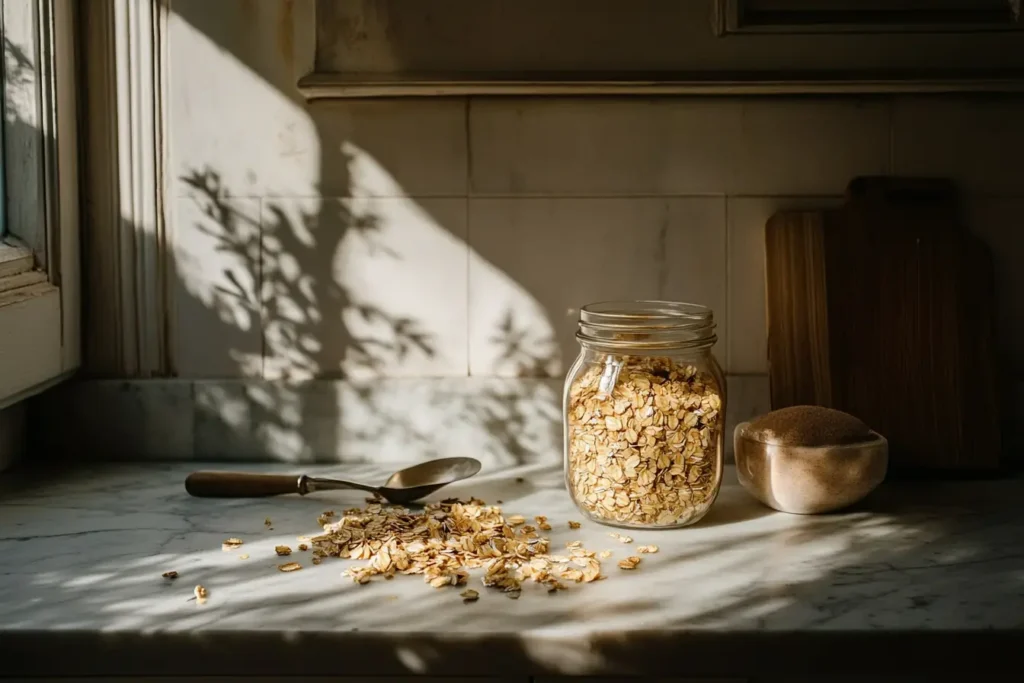Why are homemade granola not crunchy? This is a common frustration for many home bakers. You follow a recipe, mix the perfect ingredients, and bake with care—only to end up with soft or chewy granola instead of the crisp, golden clusters you were hoping for.
The secret to making crispy homemade granola lies in the right combination of ingredients, baking techniques, and proper storage. In this guide, we’ll explore the common reasons why your granola might not be crunchy and provide expert tips to help you achieve that perfect texture every time. Let’s dive in!
Table of Contents
Common Reasons for Homemade Granola Lacking Crunch
Crunchy granola doesn’t happen by accident—it’s a delicate balance of ingredients, techniques, and timing. Let’s explore why your granola might turn out soft or chewy instead of crispy.
The Importance of Texture in Granola
Granola’s signature crunch isn’t just about taste; it’s a sensory experience. That light, crisp bite comes from carefully balancing moisture levels and creating a uniform, toasted surface. If granola isn’t crunchy, it often feels heavy, losing its appeal as a quick, satisfying snack.
The Role of Moisture Content
One of the most common culprits behind soft granola is excessive moisture. Ingredients like fresh fruit, wet sweeteners (like honey or maple syrup), or improperly dried oats can introduce too much liquid. This prevents the granola from crisping up during baking.
Incorrect Baking Temperatures and Times
Baking at the wrong temperature is a recipe for disappointment. If your oven is too hot, the granola may burn before it fully dehydrates. On the flip side, a temperature that’s too low can leave it chewy, as the moisture doesn’t evaporate completely. Additionally, rushing the process or underbaking can result in a lackluster texture.
Key Ingredients That Impact Granola Crunchiness

The ingredients you use can make or break the crunch in your granola. Let’s take a closer look at how they influence texture and what adjustments you can make for perfect results.
Role of Sweeteners in Crunchiness
Sweeteners like honey, maple syrup, or agave nectar don’t just add flavor—they also play a significant role in creating that sticky, crispy coating. Too much sweetener can weigh the granola down, while too little might not bind the oats and nuts properly. If you’re struggling with soggy or softgranola, consider adjusting your sweetener ratio. For example, balancing the liquid sweeteners with a dry sugar like coconut sugar can help achieve a crispier texture.
Impact of Oils and Fats
Oils like coconut oil, olive oil, or vegetable oil are essential for giving granola its signature crunch. They help toast the oats evenly, adding richness and depth to the flavor. However, using too little oil can result in dry, crumbly granola that lacks cohesion. Aim for a balance, ensuring the oats and mix-ins are evenly coated but not saturated.
Effect of Nuts, Seeds, and Add-ins
Add-ins such as nuts and seeds can either enhance or hinder the crunch factor. For the best results, choose sturdy nuts like almonds or pecans and avoid overly soft ingredients. Additionally, be mindful of when you add mix-ins like dried fruit—if added too early, they can release moisture and soften the granola during baking.
For a detailed recipe that nails this balance, check out Vanilla Nut Granola Recipe.
Baking Techniques to Achieve Crunchy Granola
Perfecting the baking process is key to understanding why are homemade granola not crunchy. A few tweaks in your method can elevate your granola game significantly.
Low and Slow Baking: Why It Works
Patience pays off when it comes to crunchy granola. Baking at a low temperature (around 300°F or 150°C) allows the granola to toast evenly without burning. The slow process ensures the oats dry out fully, creating a light, crisp texture.
Spreading and Layering Granola Properly
Crowding your baking sheet can trap steam, leaving your granola soft and soggy. Instead, spread the mixture thinly and evenly across the pan. If you’re making a large batch, use multiple trays to avoid overlapping layers.
Stirring vs. Leaving It Alone During Baking
Stirring granola mid-bake can be a double-edged sword. While it helps prevent uneven cooking, overstirring can break up clusters and hinder crunch formation. Try stirring just once or twice during baking to find the right balance.
Curious about which ingredients help granola stick together? Visit What Ingredient Makes Granola Stick Together for helpful insights.

Avoiding Common Mistakes When Making Granola
Mistakes in the granola-making process can turn an otherwise promising batch into a disappointing one. Let’s break down the common pitfalls to avoid so you can consistently achieve that sought-after crunch.
Overcrowding the Pan
One of the biggest mistakes when baking granola is piling everything onto a single pan. Overcrowding prevents the granola from toasting evenly, trapping steam and leaving it soft. For the best results, use multiple baking sheets and spread the mixture in a thin, even layer. This ensures proper airflow and helps the granola crisp up perfectly.
Using the Wrong Type of Oats
Not all oats are created equal when it comes to granola. Rolled oats are your best bet, as they hold their shape and crisp up beautifully during baking. Quick oats, on the other hand, tend to clump and become mushy. Avoid steel-cut oats as well—they take much longer to cook and don’t achieve the desired crunchy texture.
Not Allowing Granola to Cool Properly
Skipping the cooling step can be a dealbreaker. Granola hardens and develops its crunch as it cools, so removing it from the pan too early can result in a chewy mess. Leave the granola undisturbed on the baking sheet until it cools completely to lock in the crunch.
For more tips and delicious recipes, consider exploring our other articles on granola perfection. Check out our vanilla nut granola recipe for inspiration.
Tips for Storing Homemade Granola to Maintain Crunch
Even the crunchiest granola can lose its texture if not stored properly. Proper storage techniques are essential to maintain the crispness of your homemade treat.
Why Storage Matters
Granola can absorb moisture from the air, which is one of the main reasons it loses its crunch over time. Understanding how to store granola properly ensures it stays crispy for weeks.
Airtight Containers and Moisture Control
The best way to keep granola crunchy is by storing it in an airtight container. Glass jars with tight lids or resealable plastic bags work well to prevent air and moisture from seeping in. For extra protection, consider adding a desiccant packet to absorb excess humidity.
The Role of Temperature in Storage
Where you store your granola matters too. Keep it in a cool, dry place, away from direct sunlight. Avoid storing granola in the fridge, as the moisture inside can make it soft. For long-term storage, freezing granola in a sealed bag is an excellent option—it stays fresh and crunchy for months.

Wrapping Up – Perfecting Crunchy Homemade Granola
Mastering the art of homemade granola might take a few tries, but it’s well worth the effort. Understanding why are homemade granola not crunchy comes down to tackling key factors like ingredient choices, baking techniques, and storage methods.
Start by using rolled oats and the right ratio of sweeteners and oils. Bake your granola at a low temperature, spread it evenly, and avoid stirring too often. Once you’ve nailed the baking process, store your granola in airtight containers to keep it crispy for days.
With these tips and tricks, you’ll soon be enjoying granola that’s every bit as crunchy and delicious as store-bought versions—only fresher and more customizable to your taste. Happy baking!
Customizing Granola for Texture and Flavor
The beauty of homemade granola is its versatility. You can experiment with different ingredients to create unique textures and flavors while ensuring that signature crunch.
Adding Clusters for Extra Crunch
Granola clusters are not only visually appealing but also enhance texture. To create clusters, mix your granola with an extra helping of a sticky binder like honey, maple syrup, or nut butter. Press the mixture firmly onto the baking sheet before baking, and avoid stirring until it’s fully cooled. This method helps the granola stick together and form delightful clusters.
Experimenting with Add-ins
For a satisfying crunch, consider mixing in sturdy nuts like almonds, cashews, or pecans. Toasted coconut flakes or seeds like sunflower and pumpkin can also elevate both flavor and texture. Just remember to add delicate ingredients like dried fruit or chocolate chips after baking to prevent them from burning or melting.
Why Are Homemade Granola Not Crunchy? Common Questions and Troubleshooting
Understanding why are homemade granola not crunchy often involves identifying specific missteps and resolving them. Here are some additional troubleshooting tips.
Identifying and Fixing Soft Granola Issues
If your granola consistently turns out soft, check your baking process. Are you using too much liquid sweetener? Are the oats properly coated in oil? Also, verify your oven temperature—it might not match the dial reading. Using an oven thermometer can help ensure accuracy.
Avoiding Moisture Post-Baking
Sometimes, granola loses its crunch after being stored. To fix this, make sure it’s completely cool before sealing it in an airtight container. Any residual heat can create condensation, softening the granola. If this happens, a quick re-toast in the oven can help restore its crispness.
Keeping the Crunch Long-Term
For long-lasting crunch, store your granola in a cool, dry place. If you live in a humid area, consider adding a silica gel packet to your storage container to absorb moisture. Proper storage makes all the difference in maintaining texture and flavor.
FAQs
Granola-making can spark many questions, especially when aiming for that perfect crunch. Here are some of the most frequently asked questions about homemade granola and their answers.
What Makes Granola Crunchy?
Granola’s crunch comes from a balance of the right ingredients and baking techniques. Sweeteners like honey or maple syrup help create a caramelized coating, while oils ensure even toasting. Baking at a low temperature and spreading the mixture thinly also play vital roles in achieving that golden, crispy texture. If you’ve ever wondered, “Why are homemade granola not crunchy?”, it’s likely due to issues with one of these elements.
Can I Fix Granola That Turned Out Soft?
Yes! Soft granola isn’t a lost cause. Simply spread it back onto a baking sheet and toast it in the oven at 300°F (150°C) for 5–10 minutes. Make sure to let it cool completely after reheating—it will harden as it cools.
Should I Add Honey Before or After Baking?
It’s best to mix honey into the granola before baking. This allows it to coat the oats and nuts evenly, helping create clusters and enhancing the crunch. Adding honey after baking can make the granola sticky rather than crispy.
Is Crunchiness Affected by the Type of Oven?
Yes, your oven type can affect the outcome. Conventional ovens provide even heat, but if you’re using a convection oven, the fan can speed up the toasting process. Lower the temperature by 25°F (about 15°C) if using a convection oven to prevent burning while ensuring the granola dehydrates fully.
Conclusion
Homemade granola is a joy to make, but achieving that perfect crunch can sometimes be a challenge. By understanding why are homemade granola not crunchy and addressing common issues—like balancing ingredients, perfecting baking techniques, and using proper storage methods—you can consistently create delicious, crispy granola that rivals store-bought options. Remember to choose rolled oats, spread the mixture evenly on a baking sheet, and bake low and slow for the best results.
With these tips and a bit of practice, you’ll master the art of making granola that’s as crunchy as it is flavorful. Whether you enjoy it with yogurt, milk, or as a snack, your homemade granola will always be a satisfying treat. Now, it’s time to head to the kitchen and bake your way to granola perfection!
Homemade granola is more than just a breakfast staple—it’s a canvas for creativity and a healthier, customizable alternative to store-bought options. However, the key to taking your granola from good to great lies in its texture. Crunchy granola doesn’t happen by chance; it’s the result of carefully chosen ingredients, precise baking techniques, and proper storage practices.
If you’ve been asking yourself, “Why are homemade granola not crunchy?”, the answer often lies in small details. From the type of oats you use to the temperature of your oven, each step contributes to that delightful crispness. Avoid overcrowding your baking sheet, balance your wet and dry ingredients, and don’t rush the process—low and slow baking is your best friend.
Storage is equally important. No one wants granola that turns soft after a few days. Keep it cool, dry, and airtight, and consider freezing it for extended freshness. By following these guidelines, you can ensure your granola remains as crunchy as the day you baked it.
So, why stop at store-bought granola when you can craft your own perfect blend? With the right techniques and a little patience, you’ll never settle for less than the perfect crunch. Now, grab your favorite mix-ins, preheat that oven, and get ready to enjoy the best granola you’ve ever made. Your breakfast (and your taste buds) will thank you!
Dernière mise à jour : 07 February 2025

